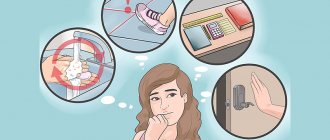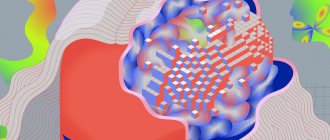Post-traumatic stress disorder - PTSD - four letters that every specialist in the field of psychology or psychiatry can decipher.
The diagnosis of “post-traumatic stress disorder” is overly popular in society and is often used inappropriately, which devalues the meaning of the term itself. Before we talk about PTSD, it is necessary to define what stress is. The founder of the doctrine of adaptive reactions, G. Selye, introduced the concepts of eustress and distress. Eustress is “good” stress, in which the protective reaction occurs without loss to the body, that is, painlessly; distress is excessive stress, leading to disorganization of the body and weakening of its capabilities. It is clear that the higher the intensity of the stressor, the higher the likelihood of eustress turning into distress. All people are susceptible to stress, but their reactions to it may vary.
PTSD
– a delayed and/or protracted reaction to a stressful event (short-term or long-term) of an extremely threatening nature, which can cause distress in almost any person.
What is the "Vietnamese syndrome"?
Research into the disorder began with wars, when doctors noted similar symptoms in soldiers and veterans. Therefore, the first names for PTSD were “soldier’s heart”, “Vietnam syndrome”, “Afghan syndrome”, depending on the name of the war in which people participated. Among the common symptoms were: feelings of horror, fear, helplessness, nervous excitability and irritability, detachment and psychological fixation on the event that occurred. Later it was discovered that the nature of mental changes was similar in people who suffered natural disasters, violence and other disasters.
Who gets PTSD?
The frequency of the disorder in the general population reaches 8%.
PTSD can affect anyone at any age, although women, children and older adults are thought to be more likely to develop it. After a traumatic experience, most people experience an acute stress reaction, which has some overlap in symptoms with PTSD. This reaction in most cases goes away within a month, but not everyone is so lucky. The disorder is based on severe psychological trauma or a traumatic situation that is life-threatening or terrifying. Psychotramatic actions are not always committed against the patient; he can be a witness (for example, the death of a loved one) or even a performer (for example, combat veterans). These emotions resemble “heavy” food, which cannot be digested in the stomach and creates heaviness; accordingly, PTSD can be called a kind of “psychological indigestion.”
Causes of PTSD
What events are most likely to cause PTSD and in whom?
Is it possible to name clear criteria for events that will cause PTSD? In other words, does it make a difference whether a person witnessed violence or was himself subjected to, for example, detention, beating, where they hit you once or several times, whether there was physical injury or a verbal threat?
— According to the international classification of diseases, for PTSD to occur, the event must be unusual in intensity, threatening or catastrophic in nature, the doctor lists the criteria. “However, discussions are currently underway and the criteria are being revised, taking into account the individual sensitivity of a particular person. For some people, PTSD symptoms can arise from a less acute event, such as a woman experiencing a miscarriage, although this is not unusual in our society.
PTSD can be:
- in a trauma survivor;
- a witness of traumatic events;
- for people whose loved ones have suffered.
“At such moments, a person is faced with the reality of death and the painful experience of his helplessness. Helplessness is one of the most traumatic factors, the specialist emphasizes.
“Most of us live in the illusion of our own immortality and the justice of the world around us: “death will not come soon, and if I behave well, nothing bad will happen to me.” In a traumatic experience, a person is faced with the opposite: anything can happen to anyone, and nothing can be done about it. Therefore, the number of blows thrown does not matter. Moreover, PTSD can occur without physical violence, but as a consequence of a state of humiliation and loss of control over one’s life at the moment, a verbal threat of death, when a person may not be touched with a finger, but he understands that potentially anything can happen to him whatever.
Main causes of the disorder:
• aggressive attack, threat of death or injury, rape, including using blackmail, defenseless or dependent position; • long-term serious illness, death of loved ones; • physical or psychological torture; • natural and man-made disasters (tsunamis, earthquakes); • epidemics, including coronavirus infection; • social reasons (revolutions, terrorism, mass repressions, genocide, financial and economic crises, forced migration, chronic family violence); • hostilities; • religious, ethnic, cultural conflicts, etc.
A separate category is complex or complex PTSD, a condition caused by a severe chronic situation over several months or years. It is more often observed in those who experienced trauma in childhood.
Risk factors also include heredity, congenital and acquired psychological characteristics (characterological, neurophysiological, personal), past psychological trauma, social conditions, characteristics of working conditions (rescuers, military, journalists), economic situation.
Other causes of PTSD
Other equally significant traumatic causes include:
- natural disasters - earthquakes, floods, hurricanes;
- man-made disasters - explosions, collapses of buildings, mines;
- Act of terrorism;
- taking and holding hostages;
- miscarriage or loss of a child;
- evidence of violence;
- financial difficulties.
In addition, there are factors that have a purely individual significance for a person. This could be the death of loved ones, any threat to life, physical and sexual violence, serious illness, one’s own or a relative’s, betrayal of a spouse.
At the age of 13, the young man was attacked and injured with a knife. After this, he developed PTSD, and at age 17, symptoms of a panic attack began. From the anamnesis it was known that in childhood the young man was repeatedly subjected to physical, psychological and even sexual violence.
Stressful situations that cause PTSD are divided into single and systemic. An example of a single factor is a natural disaster, while systemic ones include, for example, a long stay as a hostage.
Susceptibility to stressors and the occurrence of PTSD also depends on the individual characteristics of the individual. For example, it has been established that people with a narcissistic personality type, as well as with dependent and avoidant behavior, those who tend to get stuck and fixate on negative events, neurotic, impressionable and labile psychotypes are more prone to its formation.
Workers in extreme areas are at risk of developing this disorder: rescue workers, doctors, military personnel, journalists, etc., as well as elderly people and children. In childhood, the likelihood of acquiring the disease increases due to the underdevelopment of psychological defense mechanisms in children. In old age, these mechanisms, on the contrary, are lost, and the speed of mental processes slows down.
How does a person feel with PTSD?
Symptoms usually appear within the first few weeks after the injury, but can begin within 6 months and persist for a long time.
Description of some signs:
• Intrusion of memories - the traumatic event is constantly relived - repeated illusions, frightening thoughts, nightmares and flashbacks (“flashbacks”) with the presence of physical symptoms when reminded of the experienced event (sweating, numbness of the limbs, feeling of weakness, pressure in the throat, itching, chills); • Attempts are made to avoid stress-inducing stimuli associated with trauma after the event - the person tries to keep himself busy and avoids situations and people that remind him of the experienced event; • Negative changes in mental activity and mood - a person cannot remember some episodes during a traumatic event, a marked decrease in interest in previously significant activities, constant negative emotions, a feeling of alienation and detachment from other people and the world; • Changes in arousal and responsiveness – aggressive behavior, sleep disturbances, difficulty concentrating, hypervigilance, increased startle response.
Symptoms of PTSD may change in intensity over time.
The clinical picture is usually represented by additional symptoms that are consequences of PTSD. For example, many of the patients fall into alcohol or drug (or, alternatively, drug) addiction, which they cannot get rid of for the rest of their lives. People with PTSD often have somatic and psychosomatic disorders in the form of headaches, arthritis-like pain, stomach ulcers, pain in the heart, colitis, and breathing problems. Often the disorder occurs together with depression, suicidal thoughts occur, including suicide attempts.
What happens when trauma leads to PTSD, using the example of a woman in childbirth
During childbirth, a woman in labor perceives this or that situation as a threat to her own life or the life of her child. The woman feels helpless or unable to influence the situation, that is, she is in a state of acute stress. At the same time, there is a powerful release of adrenaline and cortisol, which we need to quickly react to danger (to run away from it or fight back). There is an assumption that this leads to biochemical reactions in the brain and a decrease in hippocampal activity.
The hippocampus is a part of the brain that is responsible for the mechanisms of memory and emotions. As a result, the traumatic memory is not processed in memory and consists of unrelated fragments. Under the influence of triggers, memories are reproduced again and again: the woman not only sees nightmares about her childbirth, but as if she is experiencing them again and again in reality, a “stuck” occurs. The body perceives this as a constant situation of mortal danger. As a result, nightmares, flashbacks, mood swings and panic attacks occur.
Post-traumatic disorder is a signal that the psyche has not coped with a traumatic situation on its own.
What provokes
Post-traumatic stress disorder occurs in response to a psychotraumatic factor and is characterized by a disruption of the normal functioning of the psyche. The disease leads to the emergence of psychopathological conditions that bring great difficulties to all spheres of human activity, destroying the family and pushing the person, ultimately, to social isolation and loneliness.
Of course, not all people exposed to severe stressors are susceptible to PTSD. However, it develops in 70% of people who experience a traumatic event. His appearance is evidence of complete helplessness, powerlessness and nightmarish horror in front of an obstacle.
First of all, people who have been in a combat zone are susceptible to this disorder. It is not for nothing that the disease is also called “Vietnamese” or “Afghan syndrome”. Having personally killed a person or witnessed a bloody massacre, such fighters experience severe shock.
But research conducted after World War II led to the formation of several hypotheses about the occurrence of PTSD:
- the presence of intrapersonal conflicts in the patient even before the outbreak of hostilities;
- Every person has their own limit of endurance. If you cross this limit, then the mechanism of psychological decompensation is triggered, and so-called combat exhaustion appears;
- the third hypothesis suggests that external factors, such as lack of sleep, overwork, and separation from loved ones, are to blame for the development of PTSD;
- conflict of interests: the desire to survive - the desire to fulfill duty.
There is a well-known story of one young American Marine who served in Afghanistan from 2008 to 2013 and was awarded awards for good service. After leaving the army, he lived with his mother. In 2017, he came to the attention of the police after vandalizing his home. A year later, in Los Angeles, he shot 12 visitors to one of the local bars, after which he shot himself. Experts have determined that the cause of the tragedy was post-traumatic syndrome, which developed during military service.
The study of post-traumatic disorder began in 1888. At this time, Hermann Oppenheim (a German neuropathologist) introduced the concept of post-traumatic neurosis into use. And he combined under this name many symptoms that are today classified as PTSD.
Diagnostics
Diagnosis of the disease is carried out by a psychologist, psychiatrist or psychotherapist.
To make a diagnosis of post-traumatic stress disorder, the patient's medical history is carefully studied and a detailed clinical interview is conducted, including with relatives and friends. The conversation uses scales, tests and questionnaires that assess the patient’s condition, the presence of depression and anxiety. Types of disorder:
- Acute – symptoms persist for less than three months;
- Chronic - symptoms persist for three months or more;
- Delayed—symptoms occur at least six months after completion
influence of a stress factor. PTSD is differentiated from acute stress disorder and obsessive-compulsive disorder. Symptoms of acute stress disorder appear and disappear within four weeks of the trauma. If symptoms persist longer, the diagnosis should be changed to PTSD. Obsessive-compulsive disorder is characterized by obsessive thoughts and rituals that are not related to a specific traumatic event. Thus, to be diagnosed with PTSD, symptoms must persist for at least one month after the event and have a negative impact on the sufferer's work or personal life.
Forms of PTSD
Depending on the predominance of the group of symptoms, the disorder proceeds according to different scenarios.
Its anxious type is accompanied by a feeling of constant, unmotivated anxiety, up to and including panic attacks. Emotionally, such people become unstable and are systematically accompanied by nightmares.
Our Max is a typical anxious type. As his disorder worsened and he began to fear for his daughter's safety, images of her abuse began to appear before his eyes. Attention became unstable, he lost orientation in space and in his personality. While driving a car, I suddenly lost the ability to control it. He couldn't control even the most basic things. The man stopped communicating with friends, his career went downhill.
According to another scenario, a person experiences severe apathy and loss of strength . He cannot motivate himself to action; he spends the entire day motionless in bed. Such an individual is indifferent to both himself and others, his state is depressed.
The dysphoric type of disorder is aggression and irritability towards loved ones, often unconscious. This form of PTSD often accompanies soldiers returning from hot spots. They are suspicious and distrustful, do not want to accept outside help, unlike asthenic patients who willingly agree to therapy. The fighters themselves often say that attacks of aggression frighten them, too. They draw attention to their conflict and inability to compromise, demand complete submission and lose control over themselves. Some personally ask their wives to lock themselves with their children in another room in order to protect themselves from uncontrollable aggression.
The somatoform variant of the disorder is characterized by unpleasant sensations in the body, and usually accompanies a delayed form of the disease. Worrying symptoms include headaches and migraines, tachycardia and heart pain, digestive disorders, tremors of the limbs, as well as dry skin or excessive sweating. Such symptoms are usually confusing in making a correct diagnosis.
Forecast
The nature of the disease is highly individual. Some recover within 6 months, while others take much longer to develop symptoms. For some people, such conditions become chronic, and the earlier treatment begins, the better the prognosis for recovery. There is also strong evidence that patients benefit from treatment even if symptoms persist for years. If left untreated, growing physical and psychological pain leads to depression, suicidal thoughts, and the formation of various addictions.
PTSD Therapy
For post-traumatic disorder, professional help is needed to assess the person’s condition and select therapy.
In an acute condition, before seeking help, it is necessary to be close to the person, support and show more attention. A person has the right to “mourning”, has the opportunity to speak out and cry. However, if after six months the reaction does not subside, you need to seek help. PTSD therapy includes two key areas: psychotherapeutic and medication.
People rarely seek psychotherapy because they do not want to be immersed in painful memories that they constantly experience in dreams or in reality, they experience shame (when raped), a feeling of guilt (when a person walked past a traffic accident and did not call an ambulance). The person believes that “no one will understand” and “can’t help” and perceives meetings with a psychologist or psychotherapist as a potential threat, another traumatic event.
Despite the painful memories, it is necessary to relive these events. At the moment of psychological trauma, the body does not understand what is happening and what to do with these events and impressions. Therefore, it is necessary to live through this situation again so that the brain understands what happened and “processes” the information.
Although there are different types of psychotherapy, in any case it involves conversations with a specialist in order to treat a mental disorder. It is important for anyone suffering from PTSD to be treated by someone who has experience working with the disorder.
First, a trusting relationship with the doctor is built, the patient is told about what PTSD is, and is prepared for the need to return to painful traumatic experiences. When talking with a doctor or psychologist, a person will not be judged; only a non-judgmental acceptance of the experience will occur. Each conversation is conducted in a safe environment in the absence of contact with a traumatic factor. Therapy is aimed at creating positive feelings of self, resources for coping with emotions and adapting to current events. Then, based on scattered memories, a holistic picture is created, which must be accepted and integrated into personal history. After integration, new guidelines, prospects and goals in life are determined. A course of psychotherapy lasts from 6 to 12 weeks or longer.
Body-oriented therapies
include techniques such as physiotherapy and osteopathy, massage, acupuncture, reflexology, yoga, meditation. This therapy focuses on using body language to heal the mind and is based on working with sensations.
Cognitive behavioral therapy
(CBT) helps you learn to think differently about your memories so that they become less disturbing and more manageable.
It usually involves relaxation to help process the discomfort caused by traumatic events. The most recommended CBT method is Shapiro's eye movement desensitization and reprocessing.
This therapy involves the patient following the movement of the therapist's finger while imagining that they are experiencing the traumatic event. The idea is that the effect of rapid eye movements will be similar to the way our brain processes memories and experiences during sleep. Group psychotherapy
helps you feel less lonely and isolated, and helps group members understand that many people would react the same way and experience the same emotions. A “feeling of comradeship” develops when group members share common problems with each other. Over time, each group member's feelings of shame and guilt decrease, and confidence in progress after therapy increases.
As an auxiliary method of psychotherapy
most often used: hypnosis (suggestion); auto-training (self-hypnosis); relaxation methods (breathing exercises, oculomotor techniques, etc.); healing through fine art.
Ultimate goals of psychotherapy:
- To help better understand the nature of the traumatic event and its effects;
- Help you learn and apply relaxation and anger management skills;
- Provide recommendations on how to improve your sleep quality, improve your diet, and make exercise a habit;
- Help recognize and control feelings of guilt, shame, and other feelings associated with the traumatic event;
- Take measures to correct the reactions of others to their symptoms of PTSD.
Medication methods include
– antidepressants, anxiolytics, neuroleptics and anticonvulsants. Pharmacological therapy is required to relieve the acute stage of PTSD. Their use depends on the main complaints and painful manifestations of the patient. Selective serotonin reuptake inhibitors (SSRIs) have the greatest evidence base. SSRI drugs reduce anxiety and make it easier for the patient to begin the process of psychotherapy.
Before you start taking the drug, possible side effects or withdrawal symptoms are discussed with your doctor. Treatment is usually long-term: at least 12 months pass before the dose is gradually reduced and the drug is discontinued. Recommendations for pharmacotherapy vary somewhat among clinical guidelines, but in most cases medications are recommended in conjunction with psychotherapy.
Everyone is different, and a treatment that works for one person may not work for another or may even make it worse. Therefore, it is necessary to entrust mental health to specialists!
Post-traumatic stress disorder (PTSD)
Page 1 of 5
In modern conditions of a tense socio-economic situation, local wars, terrorist attacks, natural and man-made disasters, increased mortality and crime, when people find themselves in conditions of acute and/or chronic mentally traumatic events, the study of post-traumatic stress disorder (PTSD) is an urgent problem. both clinically and socially. PTSD is a psychogenic disorder that is caused by exposure to severe stressors. The first historical stage in the study of PTSD was characterized by a description of acute disorders associated with combat trauma . Subsequently, in the middle of the 20th century, similar reactions of the body were observed during natural and man-made disasters, fires, and among survivors of the atomic bombing in Japan, which were accompanied by mass deaths. Intrusive and depressing memories of events, anxiety attacks, and emotional decline were defined as “post-traumatic neurosis of survivors” or “post-traumatic psychological illness,” which emphasized the role of psychological factors in the formation of these conditions and indicated the emergence of a second stage of PTSD research.
The chronic consequences of psychological trauma began to be studied in the 48s of the 20th century among former prisoners of concentration camps, who were found to have depression, anxiety in combination with various somatic symptoms, fear and paranoia, total distrust of others, personal changes [cit. from 67].
By the end of the 70s, significant material had already been accumulated, which, despite the differences in the nature of mental trauma, indicated the presence of a number of general and specific clinical signs.
The concept of post-traumatic stress disorder (PTSD) first appeared in the American classification DSM-III in 1960 and was considered within the framework of neurotic disorders (“anxiety neurosis”, “transient situational disorders”) based on diagnostic criteria developed by M. Horowitz et al. This indicated the emergence of a third stage in the study of this disorder. Since then, considerable effort has been devoted to research into the etiology, pathogenesis, risk factors, phenomenology and comorbidity associated with PTSD, as well as treatment, including communication training. In Russian psychiatry, the diagnosis of PTSD appeared only at the turn of the 21st century.
The frequency of PTSD, according to different authors, differs depending on the material studied, the application of diagnostic criteria, the characteristics of the population being examined, and the research methods used. According to American authors, the prevalence of PTSD among the population is 8-9%. Russian researchers indicate that its frequency in the population ranges from 1 to 12% and varies depending on the frequency of disasters and traumatic situations in the range of 48-80%.
It is clear that the prevalence of PTSD increases during tragic events that affect large numbers of the population. Some authors believe that 61% of men and 49% of women have experienced at least one traumatic event in their lives, many (25-48%) have experienced two or more psychological traumas. A further increase in mental disorders in response to mental trauma .
Research into external influences on humans continues. They describe PTSD under the influence of stressors of various types, both acute and chronic, in particular during natural disasters, in hostages, in victims of terrorist acts, in the commission of physical, sexual violence, social violence, in childhood trauma, including incest, violence committed in the family, among refugees, during man-made disasters, during car accidents, during unemployment, among migrants and internally displaced persons. of combat stress continues .
Victims can be not only directly injured people, but also eyewitnesses of the events, relatives, rescuers, medical personnel, firefighters, becoming a hidden victim during the provision of assistance in disasters.
However, it has been noted that not all subjects who experience the same stressful event develop PTSD. In recent decades, in the development of the disorder, great importance has been attached to risk factors: etiological, biological, psychological, socio-psychological and others. Risk factors include the nature of the stressor, its content, duration, severity, strength, suddenness of action, and others. Repeated traumatic events to which a person is exposed are a high risk factor for the development of PTSD. At the same time, further study of stress factors is required.
It is suggested that the main factors influencing the development of PTSD are personal characteristics. It has been revealed that in the development of the disorder, extramorbid personality characteristics, its orientation, gender, age, life experience, resistance to stress, the presence of mental and psychosomatic disorders in the past, somatic diseases, traumatic brain injuries, injuries, addictions, and poor treatment play an important role. childhood - physical, sexual and emotional (psychological) violence. Particular importance is attached to the attitude of the victim himself to what happened. It is argued that the development of PTSD is due to the susceptibility of some people to stress. It is noted that an important internal condition that determines the subject’s ability to survive the trauma received is the presence of special personality traits that develop as a result of a disruption in the process of its formation. Of great importance in the formation of PTSD, both in acute and chronic mental trauma, is given to negative upbringing conditions and poor treatment of children. They describe the influence of socio-psychological factors, including negative family relationships, educational conditions, leading to personality pathology in PTSD, including violations of its identity.
At the same time, it is believed that risk factors play a significant role only in certain individuals, and their influence cannot be generalized to all patients with PTSD. The mechanism of these influences continues to be studied and refined. The role of internal and external risk factors is currently practically undisputed, however, a consensus on their significance has not been developed to date.
The pathogenesis of PTSD development is not fully understood. Biological mechanisms, psychological, informational and others are considered. Among the variety of theories of the pathogenesis of PTSD, the modern psychosocial approach is of interest, according to which the model of response to mental trauma is multifactorial, therefore it is necessary to take into account the role of various factors in the development of the response to stress. Biopsychosocial theories are promising.
At the same time, the psychological reactions that arise in response to severe traumatic events have not received due attention to this day. The variety of approaches to studying PTSD and the difficulties faced by researchers may be due to the lack of a unified theory and a unified definition of stress .
PTSD can last for several years. There is increasing interest in the study of conditions caused by chronic psycho-traumatic situations.
Some authors find that the typical form of PTSD is extremely rare in its chronic course. For this reason, chronic PTSD is often not diagnosed, since untreated acute post-traumatic syndrome develops over time and can manifest itself with completely different pathological signs, making it possible to make different diagnoses. Chronic PTSD is considered a common disorder, present since childhood in 87% of cases.
The consequences of unrecognized PTSD are considered serious, affecting both the individual and his immediate environment, family and friends, which leads to further worsening of the problems. Based on these considerations, it is emphasized how important a timely diagnosis of PTSD is for seriously traumatized people and considers it crucial for clinicians to keep this diagnosis in mind along with any other.
In recent years, works have appeared aimed at systematizing the clinical signs of chronic PTSD, in particular, the types of the disorder have been identified. The results of a study of clinical and dynamic manifestations of chronic PTSD are presented. At the same time, a number of clinical aspects remain unspecified and debatable.
Combination treatment for PTSD is considered the most appropriate. Drug therapy for PTSD should go hand in hand with resolution of the traumatic situation and psychotherapy. The principles of psychological and psychiatric care in emergency situations are well developed mainly in the acute period of mental trauma. Treatment of chronic PTSD requires modern, differentiated approaches taking into account the characteristics of the clinical picture.
Many methods of psychotherapy have been proposed, the main ones being cognitive-behavioral, psychodynamic, desensitization, hypnosuggestive, and family. At the same time, there are no uniform approaches to psychotherapy for the disorder. Specialists use in their work mainly certain aspects of pathogenesis and clinical manifestations. This necessitates the development of psychotherapeutic, pathogenetically oriented, multi-level programs, including not only clinical, but also personal and socio-psychological aspects.
A targeted study of chronic PTSD, identification of clinical features, patterns of dynamics, psychological and socio-psychological risk factors contributing to the development of the disorder, will allow us to obtain a more complete understanding of chronic PTSD, as well as to develop a personally and socio-psychologically oriented program of psychotherapy for the disorder.
- Forward
PTSD in children and adolescents
In general, children experience symptoms similar to adults, but there are some symptoms that are more specific to children under 6 years of age, such as urinary incontinence, separation anxiety or increased anxiety, acting out a scary event in games, and others.
Children with PTSD become withdrawn, moody, irritable, and their academic performance declines. With a long course of PTSD, children are significantly behind in mental and physical development, and they develop irreversible pathological deformation of character traits. Adolescents, earlier than adults, develop a tendency toward antisocial, destructive behavior and the development of addictions. Older children and teens may feel guilty for not preventing injuries or deaths.
Emergency assistance for children and adolescents involves establishing physical contact (picking up, hugging, touching a shoulder or arm), reassuring (“It’s all over, I’m with you”), encouraging (“You helped me a lot,” “You did well”).
Important points of psychotherapeutic interaction with a child:
- Gradually gaining the child's trust;
- Avoiding standard procedures before talking about traumatic events;
- Creating a safe environment during therapy.
With younger children, psychological work can take place in the form of play therapy (playing with plasticine, dolls, sand therapy, storytelling, role-playing games), with older children - therapy with the help of fine arts.
To restore the child’s normal psychological state, psychocorrectional work with the family is of great importance.
If signs of distress become persistent, you should contact a child psychotherapist or psychologist.
What are the symptoms of PTSD?
Every person experiences nightmares, unpleasant thoughts, and memories of difficult events in the past. Is this PTSD?
Reliving a traumatic event
In cases of PTSD, memories, thoughts, and images come in the form of flashbacks. They feel much more real than ordinary memories - a person often perceives them as reality. Some experts classify flashbacks as episodes of confusion. They can be triggered by an event in the present tense: for example, the sound of firecrackers or the rumble of a truck can trigger a flashback to military action in a former soldier.
Many people say that PTSD is about flashbacks. It's true, and it's very unpleasant. A flashback can be caused by anything: for example, you go to the store, and something - color or light - throws you back, you stand with a pack of pasta in your hands and feel horror, having “failed” into the past. These are very vivid, rich memories, as if you are reliving a moment from the past.
Lyubov Melnikova, interview with Wonderzine magazine
Avoidance
Since flashbacks are very painful for a person, he will try to avoid events, situations, people, things that can cause them. For example, a soldier avoids crowded places. The person will also avoid obsessive thoughts about the event, for example by overburdening themselves with work and responsibilities.
In difficult times, I worked without breaks - for example, I replaced colleagues on weekends. At home I only slept, and I didn’t have a home as such - I moved around all the time. Even now, all my things fit into four boxes and a suitcase, and only now am I starting to get used to the fact that home is the place where I feel good and calm.
Lyubov Melnikova, interview with Wonderzine magazine
Negativism
Compared to how the person was before the injury, he will report that he has become more “negative.” Often people report that they have more negative thoughts or images in their minds, and they often feel emotionally worse than before. The following experiences are typical for military personnel:
- emotional deadness - what previously caused emotions now does not cause any reaction;
- shame and guilt that something happened to his colleagues that he could have prevented (from his point of view);
- anxiety and fear due to the feeling that the world and the people in it are dangerous and unreliable.
Hypersensitivity
People with PTSD are always “on guard”, do not find a place, are always waiting. This leads to problems with concentration, rapid emergence of anger and aggression, and exhaustion.
Other mental disorders
People with PTSD develop other problems: depression, alcoholism and drug addiction, self-harmful behavior, aggression towards others, and suicidal behavior.
I started taking drugs, trying to get away from the problem, then, when I stopped taking them, I drank heavily. Then there was a toxic relationship. Then there was an eating disorder. All this self-destruction was an attempt to stop thinking about the suffering that my daily life caused me.
Lyubov Melnikova, interview with Wonderzine magazine
How can you help a loved one with PTSD?
First and foremost, offer emotional support, understanding, encouragement, and patience.
If the person resists your help, give him time and let him know that you are available to talk and help if he needs it. Try not to force your loved one to talk about trauma until they are ready. Learn more about the disorder to better understand what your loved one is going through. Tune in to positive thinking: plan a family vacation or socializing with friends, encourage his participation. To correct the condition, physical activity and a healthy, balanced diet are important. Often people who have suffered traumatic events, due to the unique nature of psychological defenses, do not attach serious importance to their symptoms, perceiving this as the norm. If you see that your loved one is not coping, coordinate and plan a joint visit with a specialist.
Relatives of the victim can also seek support. When treating PTSD, it is important that those closest to you are nearby and provide support; this requires a lot of strength.
How to proceed?
It is important to carry out an information detox, remind yourself of the need to put away your things, comb the fur of your beloved cat, and carefully monitor your sleep and appetite. Notice unusual bodily symptoms, but do not constantly focus on them. A good practice on the way to work is to describe everything you see without judgment, as it is. For example, “I walked past a bus stop, there are five people waiting for a bus, there is a chestnut alley ahead, etc.” This will distract you from automatic anxious thoughts and focus on the current moment.
Otherwise, the psyche will play a cruel joke and transfer the outside world into the inner reality. Then traumatic events will unfold not only outside, but also inside us, increasing stress. The result will be avoidant behavior. The person will withdraw into himself and his situation and will not ask for help.
Call what is happening by its proper name: security threat, anxiety, violence, trauma
Allow yourself to experience what is happening, do not judge or blame yourself. Trembling, rapid heartbeat, sudden tears, severe bodily tension, overexcitement, feelings of exhaustion and helplessness, loss of concentration, memory loss and inconsistent actions are all signs of traumatic stress, a normal reaction to abnormal circumstances .
Try NOT to label any of these feelings or emotions as “shame” or “guilt” or “worthlessness” or “inferiority.” Most often these are physiological adaptive reactions developed in the process of evolution. They are not related to our personality traits, skills or character.
Don’t forget the rule of emergency behavior on an airplane: you must give oxygen to yourself first
Now many are trying to help. Some have become volunteers, others quickly respond to messages in chats and try to support people facing violence.
Remember, you are in no less stressful situation than the victims. You need help too. If you don’t take care of the safety of your own resources, you won’t be able to take care of others. Stop if you lose coordination, do not feel thirsty or hungry, your sleep has become episodic not from insomnia, but because you choose not to sleep. This will lead to exhaustion and PTSD. Take breaks. Communicate with loved ones, specially come to places that you consider safe. Listen to pleasant music, do not give up your usual household rituals.
Acknowledge the experiences of loved ones, help them name them
The people you help need a lot of effort to rehabilitate. They do not always control their emotions. If possible, do not react to negativity, but do not be overly protective, do not allow the person absolutely everything. This creates a state of helplessness that will not help overcome the crisis. And, most importantly, refrain from accusations and phrases like “I told you so.” Acknowledge the experiences of loved ones, help them name them. For example, “you’re worried now,” “I see that you’re angry,” “it’s normal to worry about what’s happening to you.” Gently remind them to seek help. If you are ready to listen, then encourage them to talk about what happened, do not interrupt, give them the opportunity to speak out. Offer simple tasks around the house - making your bed, making tea or breakfast. But don't overdo it. At first, the best thing a person in a traumatic situation can do is sleep and cry. This reaction can also be delayed and appear after days or weeks.
Time does not heal!
Our brain is designed to form and strengthen neural connections very quickly. In traumatic situations, this process accelerates even more and a “funnel of trauma” is formed, which in the future, in the most ordinary everyday situations, can arbitrarily cause the most unexpected emotional and physiological reactions.
What are the consequences of ignoring PTSD symptoms?
- subsequent development of more severe conditions: depression, chemical dependence, anxiety disorders;
- violation of tolerance (resistance) to stress, which is an integral part of the life of a modern person;
- impaired functioning at work, in the family, in free time
- serious relationship problems. The person becomes aggressive, over-emotional, unpredictable in reactions, withdrawn. Over time, all these reactions become a very heavy burden for loved ones.
If you experience complex emotions, experience a situation without being an active participant in it, this is also a normal reaction. It’s better not to be alone all the time; you can ask friends or relatives to visit you. There are also many psychological help lines where you can get advice.
In emergency cases, you can contact specialists from the Republican Scientific and Practical Center for Mental Health. Phone 8 (017) 290-4370
It’s better not to be alone all the time; you can ask friends or relatives to visit you.
REMEMBER - even a one-time visit to a psychologist or psychotherapist will significantly increase the chances of quickly overcoming a crisis situation and a normal psychological state in the future.
The tips described above are not a way to treat PTSD and do not replace seeing a specialist. They will help you notice the problem, get your bearings and give an SOS signal.
PTSD in literature
The last chapters of J.R. Tolkien's famous trilogy "The Lord of the Rings" describe the disorder of the main character of the fairy tale, the hobbit Frodo. Symptoms fit into the diagnosis of post-traumatic stress disorder: the presence of a traumatic event that poses a threat to life; marked decrease in interest in previously significant activities, depression, flashbacks, anxiety in a safe home environment, symptoms worsen annually on the anniversary of the injury or when visiting places reminiscent of the events
Quotes:
“I am deeply wounded, and I will never recover from this wound.” “Time passed. In March, Frodo fell ill again. It took all his willpower not to attract attention.” “Frodo somehow disappeared more and more from the life of the Hobbit.” PTSD is an “invisible” problem; the person looks absolutely healthy, although the disorder has not gone away.
Childhood PTSD
Post-traumatic stress disorder in children, as we have already found out, is not at all uncommon. Among its causes, the first to be highlighted is the violence that a child experiences from loved ones, both moral and physical. This also includes a disdainful attitude on their part.
A difficult test for children will be not only aggression towards them, but also unintentional evidence of crime or violence. That is, in this case the child becomes not a participant, but an observer.
In addition, the death of one or both parents, and possibly adoption, will be a strong shock for the child. Divorce of parents, change of place of residence, natural disasters and car accidents are also on the list of traumatic factors.
The school community is a special environment for a child, in which he spends a significant part of his time. Failed relationships with peers, aggression, bullying and violence on their part can become a chronic stressor that often develops into PTSD.
The disorder affects children of any age. In schoolchildren, it can be recognized by aggressive behavior towards others, often towards peers, the emergence of a fear of death, and self-blame regarding the situation that occurred. Often fear and anxiety are indirectly determined through children's drawings, games or stories.
In adolescents, PTSD also manifests itself through low self-esteem, isolation and detachment, and withdrawal from alcohol or drug addiction.
Young children, preschoolers, with PTSD often suffer from nightmares and insomnia. You may notice that they become more disorganized and distracted, have difficulty concentrating, spend more time alone, are passive, and refuse to play with other children.
Parents play a major role in diagnosing the disorder in children. Careful observation of the child will help to recognize behavioral deviations in time. The main thing is not to let everything take its course, mistaking the symptoms of PTSD for age-related characteristics.









